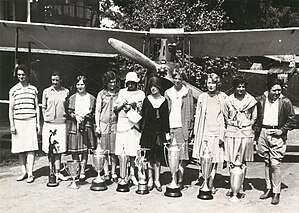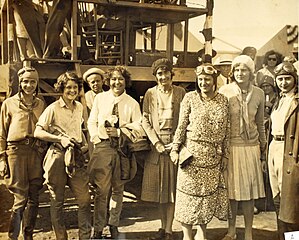
Iris Louise McPhetridge Thaden was an American aviation pioneer, holder of numerous aviation records, and the first woman to win the Bendix trophy, alongside Blanche Noyes. She was inducted into the Arkansas Aviation Historical Society's Hall of Fame in 1980.
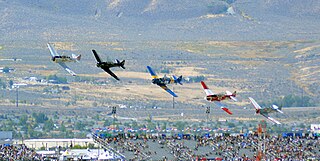
Air racing is a type of motorsport that involves airplanes or other types of aircraft that compete over a fixed course, with the winner either returning the shortest time, the one to complete it with the most points, or to come closest to a previously estimated time.

The Ninety-Nines: International Organization of Women Pilots, also known as The 99s, is an international organization that provides networking, mentoring, and flight scholarship opportunities to recreational and professional female pilots. Founded in 1929, the Ninety-Nines has 153 chapters and 27 regional 'sections' across the globe as of 2022, including a 'virtual' chapter, Ambassador 99s, which meets online for those who are too busy or mobile to be in one region for long.

The Travel Air Manufacturing Company was an aircraft manufacturer established in Wichita, Kansas, United States in January 1925 by Clyde Cessna, Walter Beech, and Lloyd Stearman.

The National Air Races are a series of pylon and cross-country races that have taken place in the United States since 1920. The science of aviation, and the speed and reliability of aircraft and engines grew rapidly during this period; the National Air Races were both a proving ground and showcase for this.

The Powder Puff Derby was the name given to an annual transcontinental air race for women pilots inaugurated in 1947. For the next two years it was named the "Jacqueline Cochran All-Woman Transcontinental Air Race" (AWTAR). It was dubbed the "Powder Puff Derby" in reference to the 1929 Women's Air Derby by humorist and aviation advocate Will Rogers.

Florence Lowe "Pancho" Barnes was a pioneer aviator and a founder of the first movie stunt pilots' union. In 1930, she broke Amelia Earhart's air speed record. Barnes raced in the Women's Air Derby and was a member of the Ninety-Nines. In later years, she was known as the owner of the Happy Bottom Riding Club, a bar and restaurant in the Mojave Desert, Southern California, catering to the legendary test pilots and aviators who worked nearby.
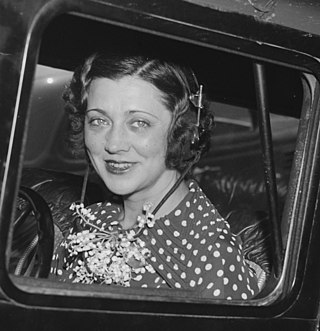
Blanche Noyes was an American pioneering female aviator who was among the first ten women to receive a transport pilot's license. In 1929, she became Ohio's first licensed female pilot.
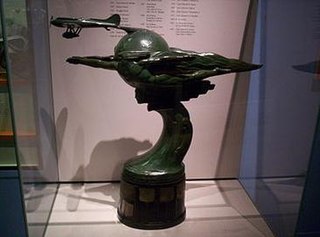
The Bendix Trophy is a U.S. aeronautical racing trophy. The transcontinental, point-to-point race, sponsored by industrialist Vincent Bendix founder of Bendix Corporation, began in 1931 as part of the National Air Races. Initial prize money for the winners was $15,000. The last Bendix Trophy Race was flown in 1962.
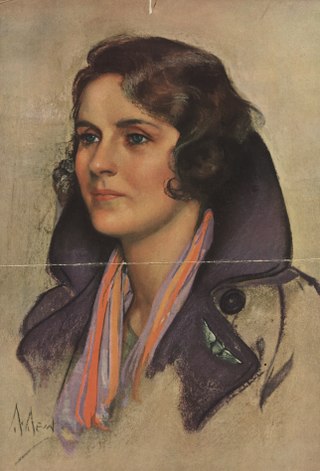
Ruth Rowland Nichols was an American aviation pioneer. She is the only woman yet to hold simultaneous world records for speed, altitude, and distance for a female pilot.
The Air Race Classic is an annual transcontinental air race for female pilots. Route lengths are approximately 2,400 statute miles (3,900 km). All flights are conducted in day visual flight rules (VFR) conditions. Each aircraft is handicapped for speed and engine power. The goal is to have the actual ground speed be as far over the handicapped speed as possible.

Phoebe Jane Fairgrave Omlie was an American aviation pioneer, particularly noted for her accomplishments as an early female aviator. Omlie was the first woman to receive an airplane mechanic's license, the first licensed female transport pilot, and the first woman to be appointed to a federal position in the aviation field.
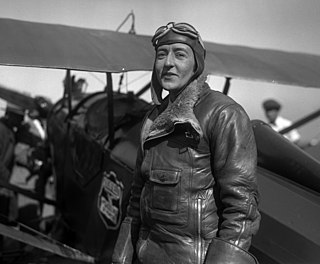
Evelyn "Bobbi" Trout was an early American aviator and endurance flying record holder. Trout began her aviation career at the age of 16; however, her first solo flight and solo certificate was not until April 30, 1928. In the spring of 1928, Trout’s mother bought her an International K-6 biplane. Trout received her pilot's identification card from the United States Department of Commerce on September 1, 1928. She was the second woman to break the non-refueling endurance record for women when she flew 12 hours straight from California in 1929. The record was previously held by Viola Gentry and was the first record where Fédération Aéronautique Internationale (FAI) rules of endurance were revised stating endurance records had to be broken by a full hour. Trout also participated in the Women's Air Derby of 1929, which was dubbed the Powder Puff Derby. In 2001, she was recognized as the only living participant in the first Women's Air Derby of 1929. Evelyn got her nickname “Bobbi” when she copied the hairstyle of 1928 actress Irene Castle which was a short “bob” haircut.
Viola Estelle Gentry was an American aviator, best known for setting the first non-refueling endurance record for women.

Opal Kunz was an early American aviator, the chief organizer of the Betsy Ross Air Corps, and a charter member of the Ninety-Nines organization of women pilots. In 1930, she became the first woman pilot to race with men in an open competition. She made many public appearances to urge more women to take up flying.
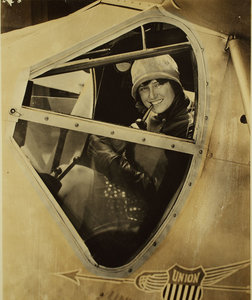
Marvel Crosson was a pioneer aviator, and the first female pilot to earn a commercial license in the Territory of Alaska. She worked in both California and Alaska, dying in a crash during the first Women's Air Derby. She was inducted into the Alaska Women's Hall of Fame in 2011.
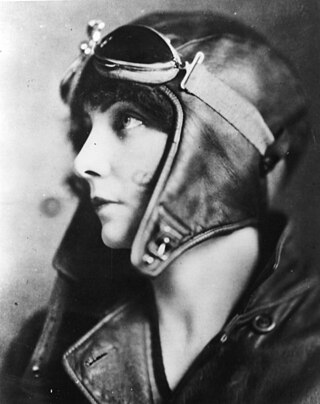
Mary Haizlip (1910-1997) was an American aviator who was the second woman in the United States to qualify for a commercial pilot's license.
Edith Magalis Foltz Stearns Grissom (1902–1956) was the first female transport pilot in Oregon, the fifth female transport pilot in the United States, and the first female state governor of the National Aeronautic Association. For her work as a transport pilot in World War II, she received the King's Medal for Courage in the Cause of Freedom. By the time she died, she had logged over 5,000 hours of flying time.

Gene Nora Stumbough Jessen is an American aviator and a member of Mercury 13. Jessen worked throughout her career as a flight instructor, demonstration pilot, advisor to the Federal Aviation Agency (FAA) and president of the Ninety-Nines. Jessen has also written about flying and the history of women in flight. Together with Wally Funk, Jessen is one of the last two surviving members of Mercury 13.
